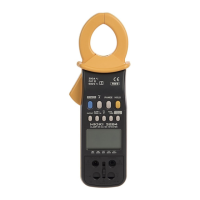28
―――――――――――――――――――――――――――
Chapter 2 Measurement Procedure
――――――――――――――――――――――――
NOTE
2.3.4 Peak Hold Measurement
・
When you switch ranges after zero-cancel
correction, deviation of the correction value will
prevent accurate measurement. (Do not perform a
zero-cancel correction when using the auto range.)
If you accidentally perform zero-cancel correction while
using the auto range, repeat zero-cancel correction after
turningthepoweroffonceandthenonagain.
・
Just after suspension of input, or when modes are
switched under no input, the counter would not
become zero for about 10 seconds. This is normal
and simply reflects the workings of the internal
circuit. But you can measure with guaranteed
accuracy before the counter becomes zero.
・
The polarity of the input is not displayed, even if DC
voltage is measured in this mode. If the connections
of test leads are moved, the measured values may
change, but the values are within the guaranteed
accuracy. (In case that you would like to measure
DC voltage which doesn't have AC components, you
should make the measurement in DC V mode.)
・
During a f.s. input, the measurement response speed
is about 250 ms during rise (0% to 90%) and about
500 ms (100% to 10%) during fall (2.2.5, Figs. 1
and 2).
・
Every range will display up to 125% of the range,
however, only the range from 10% to 100% can be
displayed with guaranteed accuracy.
・
At any range, gross errors may occur at 1% or below
of the range, whose accuracy is not guaranteed, as a
result of internal corrective calculations.
1. Press
and select a measurement mode for the
measured circuit.
2. Slide the slide cover up using the slide knob. Next,
insert the red test lead to V and the black test lead
to COM of the voltage measurement terminal.

